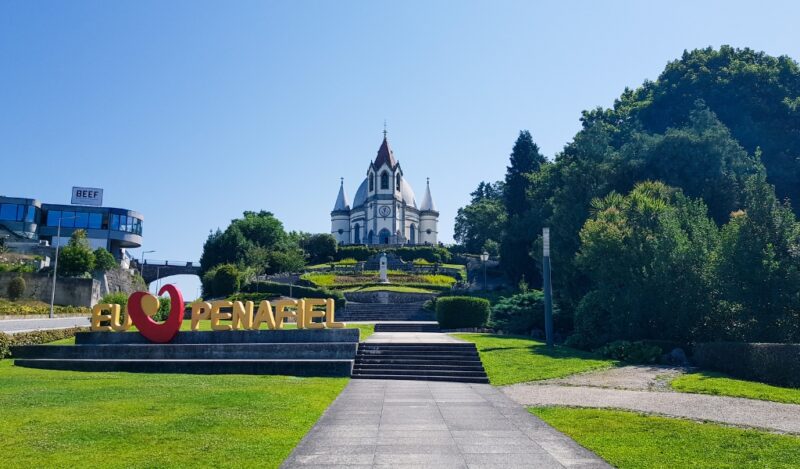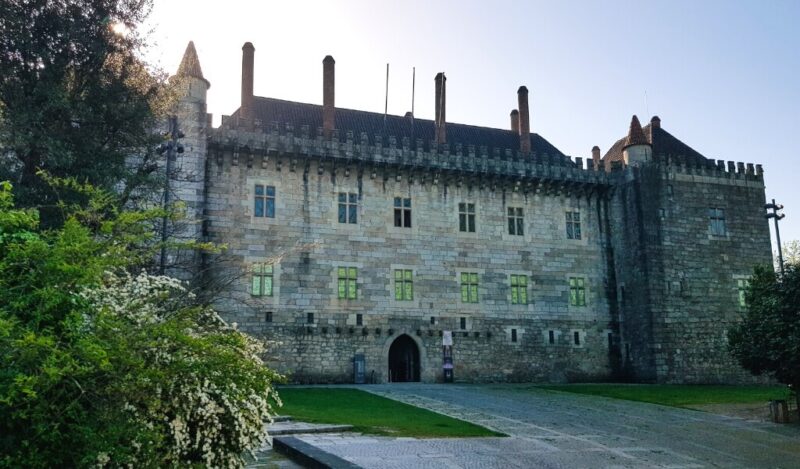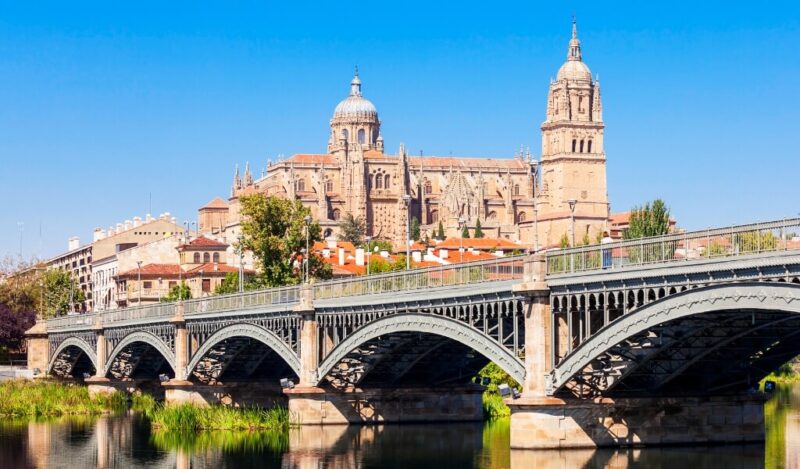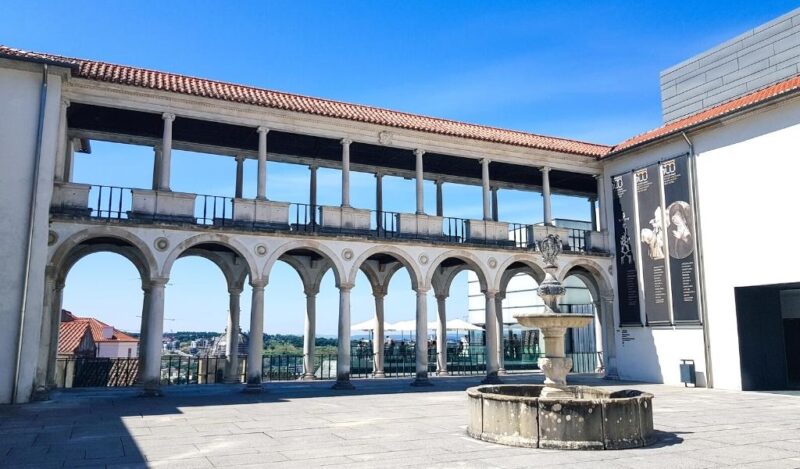The Jerónimos Monastery, Hieronymites Monastery, or Monastery of the Hieronymites (in Portuguese, Mosteiro dos Jerónimos), officially the Monastery of Santa Maria de Belém, is a Manueline-style monument that was built by King Manuel I. Situated in the parish of Belém, one of the most touristy areas of Lisbon, it has been the most visited cultural space in Portugal in recent years.
The Jerónimos Monastery was classified as a National Monument in 1907 and inscribed on the UNESCO World Heritage List in 1983, together with the Tower of Belém. In addition, it was declared one of the “7 Wonders of Portugal” in July 2007 and gained the status of National Pantheon in May 2016!
So, do you want to know How To Visit The Jerónimos Monastery In 2024? Keep reading!
This post may contain affiliate links, meaning I earn a small commission if you make a purchase, at no additional cost to you. Please read my disclosure & privacy policy for more information.
No time to read now? Pin it for later!


- Brief History of the Jerónimos Monastery
- How to Get to the Jerónimos Monastery
- What to See at the Jerónimos Monastery
- More Posts about Portugal
- More Posts about Religious Temples
- More Posts about World Heritage
- What Photography Gear Do I Use?
Brief History of the Jerónimos Monastery
In 1496, the then King Manuel I asked the Holy See for authorization to found a large monastery dedicated to the Virgin Mary and destined for the Order of Saint Jerome, on the outskirts of Lisbon. After choosing the location, on the north bank of the Tagus River and in front of the old Restelo Beach, the works began around 1501-02.
The Jerónimos Monastery benefited from substantial funding from King Manuel I, since the monarch lived during the period of the greatest expansion of the Portuguese Empire, promoting the discovery of the maritime route to India (by Vasco da Gama) and the discovery of Brazil (by Pedro Álvares Cabral). In fact, this “Portuguese Golden Age” is known worldwide as the Age of Portuguese Discoveries.

The wealth gained from maritime explorations, namely the spice trade, allowed not only to use the best possible quality raw material but also to hire the most notable artists: Diogo Boitaca, João de Castilho, Nicolau Chanterene, Diogo de Torralva, and Jerónimo de Rouen, among others.
The construction of the Jerónimos Monastery took a century, until 1601. At that time, the monument consisted of the church (with several chapels, sacristy, and high choir), chapter hall, refectory, confessionals, dormitories, and a cloister of two floors. In the 19th century, the long neo-Manueline building was added to the west of the monastery, where today the National Archaeology Museum and part of the Navy Museum are located.
World Heritage
Did you know that the Jerónimos Monastery was part of Portugal’s first set of inscriptions on the UNESCO World Heritage List? This 7th session of the World Heritage Committee took place in Florence (Italy), between December 5th and 9th, 1983.
Four other Portuguese sites were announced in the session: the Central Zone of the Town of Angra do Heroismo in the Azores; the Convent of Christ in Tomar; the Monastery of Batalha; and the Tower of Belém in Lisbon.
Nowadays, Portugal is the ninth country in Europe and the eighteenth country in the world with the most UNESCO sites, tied with Czechia and Poland. It has seventeen heritage assets (both cultural and natural) inscribed on the world list of the United Nations Educational, Scientific, and Cultural Organization.
In the meantime, I’ve already had the opportunity to visit fourteen of them:
- Alto Douro Wine Region (2001)
- Convent of Christ in Tomar (1983)
- Cultural Landscape of Sintra (1995) – Chalet of the Countess of Edla, Convent of the Capuchos, Moorish Castle, National Palace of Pena, National Palace of Sintra, Palace of Monserrate, Quinta da Regaleira, Villa Sassetti
- Garrison Border Town of Elvas and its Fortifications (2012)
- Historic Center of Évora (1986)
- Historic Center of Guimarães and Couros Zone (2001, 2023)
- Historic Center of Porto, Luiz I Bridge, and Monastery of Serra do Pilar (1996)
- Monastery of Alcobaça (1989)
- Monastery of Batalha (1983)
- Monastery of the Hieronymites and Tower of Belém in Lisbon (1983)
- Prehistoric Rock Art Sites in the Côa Valley (1998, 2010)
- Royal Building of Mafra – Palace, Basilica, Convent, Cerco Garden, and Hunting Park (Tapada) (2019)
- Sanctuary of Bom Jesus do Monte in Braga (2019)
- University of Coimbra – Alta and Sofia (2012)
How to Get to the Jerónimos Monastery
No matter which area of Lisbon you’re in, it’s very easy to reach the Jerónimos Monastery by car or public transportation. This is because the museum is served by bus (lines 79B, 201, 714, 727, 728, 729, 751), tram (number 15E), train (Cascais Line), and even by boat/ferry!
If you’re driving, you can park at Afonso de Albuquerque Square (in front of the National Palace of Belém and the National Coach Museum), or next to the Tagus River, in the Terreiro das Missas car park (between the Belém Dock and the Belém Fluvial Station) or the Electricity Museum car park.
And since Belém has such a rich heritage when it comes to monuments, museums, and palaces, why not dedicate an entire day to getting to know this historic area? For example, in the vicinity of the Jerónimos Monastery, you can visit the:
- Belém Cultural Center (and the Berardo Collection Museum)
- Calouste Gulbenkian Planetarium
- MAAT – Museum of Art, Architecture, and Technology
- Monument to the Discoveries
- Museum of Popular Art
- National Archaeology Museum
- National Coach Museum
- National Palace of Belém (and the Museum of the Presidency of the Republic)
- Navy Museum
- Pastéis de Belém House
- Tower of Belém
- Tropical Botanical Garden (belonging to the National Museum of Natural History and Science)
Opening Hours & Ticket Prices
The Jerónimos Monastery is open from Tuesday to Sunday, from 10 am to 5:30 (from October to April) or from 10 am to 6:30 pm (from May to September), with the last entry being at 5 pm and 6 pm, respectively. Besides Mondays, the monument is closed on January 1st, Easter Sunday, May 1st, June 13th (Saint Anthony’s Day), and December 24th and 25th.
If you just want to visit the Church of Santa Maria de Belém, it’s open from Tuesday to Saturday, from 10:30 am to 5 pm (from October to April) or from 10:30 am to 6 pm (from May to September ). On Sundays and religious holidays, the opening hours are from 2 pm to 5 pm (from October to April) or from 2 pm to 6 pm (from May to September).
As far as tickets are concerned, the Church of Santa Maria de Belém is free to enter. On the other hand, the Jerónimos Monastery requires entry with a ticket, which costs €10 (normal fare) or €5 (reduced fare for over 65s and holders of the Student Card or Youth Card), while children up to 12 years old don’t pay admission.
TIP: Like the other monuments and museums managed by the Directorate-General for Cultural Heritage, the Jerónimos Monastery is free on Sundays until 2 pm, for all residents in Portugal!
What to See at the Jerónimos Monastery
South Façade
Even though it’s not the main façade of the Jerónimos Monastery, the South Façade is the one you see on almost every postcard of the city of Lisbon. Facing the Empire Square, it’s entirely made of lioz stone, a type of limestone very present in the Lisbon region (especially in the municipality of Sintra).

It’s impossible not to stop to admire the impressive architecture and sculptural decoration, which make the Jerónimos Monastery one of the most emblematic examples of Manueline art. Also called late Portuguese Gothic, this style was heavily influenced by Mudejar art and is characterized by the exuberance of forms and the incorporation of elements and symbols (mostly naturalistic, regal, maritime, and religious).
South Portal
The South Portal of the Jerónimos Monastery was designed by the Spanish-Portuguese master builder and architect João de Castilho and took two years to complete (1517-18). According to historical records, more than 200 workers contributed to the construction of this triumphal structure, including masons, rigs, sculptors, etc.!

Considered one of the masterpieces of the monument, the South portal is about 32 meters high and 12 meters wide. With a much more complex iconography than the Axial Portal (on the Main Façade), it presents a sculptural group with 40 figures alluding to the history of the Holy Bible (apostles, prophets, saints, and angels) and the history of Portugal (statue of Prince Henry the Navigator, national arms, and royal medallions).
Cloister
The Cloister of the Jerónimos Monastery was designed in three successive construction campaigns, supervised by three renowned architects of that time: Diogo de Boitaca (from 1502), João de Castilho (from 1517), and Diogo de Torralva (between 1540 and 1541).


With two vaulted floors and a square plan with cut corners, the Cloister of the Jerónimos Monastery became the first cloister conceived entirely in the Manueline style. And like the cloisters of other monasteries (and convents), this was a space for meditation and recreation for the monks.


Once again, it’s distinguished by the iconographic richness of the decorative details, which combine naturalistic symbols (fantastic animals and plant motifs), royal (the armillary sphere, the cross of the Order of Christ, coats of arms, and emblems), and religious (instruments of the Passion of Christ).
Confessionals
The Confessionals of the Jerónimos Monastery are a set of twelve rooms, installed between the east gallery on the ground floor of the Cloister and the Church of Santa Maria de Belém. And did you know that the confession of sailors and pilgrims was assured by the monks of the Order of Saint Jerome themselves?

As they had taken a vow of perpetual enclosure, the confessor monks remained on the side of the Cloister, while the penitents accessed the Confessionals through the Church of Santa Maria de Belém. This means that the communication between the two parties was done through an iron grid!
Tomb of Fernando Pessoa
Fernando Pessoa is one of the most important poets of the 20th century, acclaimed for having embodied several personalities – Alberto Caeiro, Álvaro de Campos, and Ricardo Reis – whom he called heteronyms. However, his body was only transferred to the Jerónimos Monastery in 1985, on the fiftieth anniversary of his death.


The Tomb of Fernando Pessoa is also located on the ground floor of the Cloister, although in the north wing. Created by the Portuguese sculptor Lagoa Henriques, the tombstone contains an inscription of the poem “To Be Great, Be Whole” by Ricardo Reis, taken from the work “Odes by Ricardo Reis” (1933).
High Choir
Although the Jerónimos Monastery survived the massive destruction caused by the Lisbon Earthquake of 1755, there were areas of the monument that were greatly affected by the tragic natural disaster. And one of them was the High Choir, whose balustrade collapsed and was only rebuilt in 1883.


It’s known that the monks of the Order of Saint Jerome frequented the High Choir at various times of the day, to pray aloud, sing chants and participate in religious services. The choir stalls in oak and chestnut wood, of Flemish and Italian influence, were designed by Diogo de Torralva and executed by Diogo de Çarça and Filipe de Vries (the latter, the author of the polychrome wood sculpture “Christ on the Cross”).
Chapter House
The Chapter House is a hall present in almost all monasteries, convents, and collegiate churches, where meetings were held between monks, nuns, or canons and their superiors (abbots/abbesses, priors, deans, etc.).
In Portugal, some of the most extraordinary chapter houses are found in the Monastery of Alcobaça, Monastery of Batalha, Monastery of Tibães (in Braga), and Convent of the Capuchos (in Sintra).

Interestingly, the Chapter Room of the Jerónimos Monastery was never used for this purpose, as it was only vaulted and decorated in the 19th century. In fact, the only structure that was completed in the early 16th century was the door, elaborated by Rodrigo de Pontezilha between 1517 and 1518.
Tomb of Alexandre Herculano
Alexandre Herculano was a 19th-century writer, poet, historian, journalist, and politician, who stood out as the introducer of Romanticism in Portugal, defender of the national cultural and artistic heritage, pioneer of modern Portuguese historiography, and Mayor of Belém (independent municipality of Lisbon until 1855).

When he died, an Executive Committee was created to promote the projection of a mausoleum in his honor, as can be read in a historic inscription in the Chapter House.
The tomb, in neo-Gothic style and dating from 1887, was created by the sculptor Eduardo Augusto da Silva. At first, it had a sumptuous baldachin, but this was later removed.
Refectory
The Refectory of the Jerónimos Monastery was built by the master Leonardo Vaz, between the years 1517 and 1518. And, in my opinion, the most interesting detail of this great hall is its fan-vaulted ceiling, very characteristic of the Manueline style!

If you like Portuguese tiles as much as I do, then you’ll appreciate this Old Refectory of the Jerónimos Monastery even more. This is because the walls are covered with colorful tile panels from the end of the 18th century, representing episodes from the Holy Bible (such as the “Miracle of Feeding the Multitude”)!
Church of Santa Maria de Belém
The Church of Santa Maria de Belém is the best-known section of the Jerónimos Monastery and, without a doubt, the most visited (because it’s free to enter).
With a Latin cross plan, it’s surmounted by an intricate polynervated vault – which in turn is supported by six richly decorated columns.

It’s called the “hall church”, because its three naves are all the same height, creating a unique and uniform interior space.
This religious temple in Manueline and Mannerist style received the official name of Parish Church of the Parish of Santa Maria de Belém, in the middle of the last century.
Chapel of Our Lord of the Steps
The Chapel of Our Lord of the Steps is the first chapel you see on the left side when you enter the Church of Santa Maria de Belém.
In the past, it was the Chapel of Santo António, the patron saint of the city of Lisbon. From that time, the Manueline structure still survives, whose style is clearly present in the entrance arch.

When the Brotherhood of Our Lord of the Steps was founded in the 17th century, this chapel was dedicated to Our Lord of the Steps. It was also at this time that it gained its ostensible altar and finishing in gilded carving.
In 1803, the Portuguese painter António de Oliveira Bernardes added the four canvases of angels with the instruments of the Passion of Christ.
Baptismal Chapel
The Baptismal Chapel is the first chapel you see on the right side when you enter the Church of Santa Maria de Belém. That is, it’s right in front of the Chapel of Our Lord of the Steps.

Like the previous one, it was once a chapel dedicated to another saint – in this case, Saint Leonard. As far as is known, it was reformulated to serve as the Baptistery of the Jerónimos Monastery sometime in the 19th century.
Proof of this is the neo-Manueline baptismal font, which decorates the center of the small Catholic temple. This revivalist current manifested itself in Portuguese architecture and decorative arts between the mid-19th century and the beginning of the 20th century, which helps to date the creation of the Baptismal Chapel!
Tomb of Vasco da Gama
The Tomb of Vasco da Gama is one of the main “attractions” of the Jerónimos Monastery. After all, we’re talking about one of the most influential Portuguese navigators and explorers, who discovered the sea route to India!

Transferred to the Church of Santa Maria de Belém in 1880, its tomb chest was sculpted by Vítor Bastos e Costa Mota, in 1894 and in neo-Manueline style. You can find it in the subchoir, in front of the Tomb of Luís de Camões.
The decorative elements of the Tomb of Vasco da Gama include the famous symbols of the Age of Portuguese Discoveries and King Manuel I, like the cross of the Order of Christ, the caravel, and the armillary sphere, as well as plant motifs.
Tomb of Luís de Camões
If the Tomb of Vasco da Gama is on the left side, after the Chapel of Our Lord of the Steps, it’s natural that you’ll find the Tomb of Luís de Camões on the right side, after the Baptismal Chapel.

Luís de Camões is considered by many to be the greatest figure in Lusophone literature. The author of the epic poem “The Lusiads” (1572), where he precisely recounts the voyage of Vasco da Gama, became a national symbol still in the 16th century.
As you can see from the style, the Tomb of Luís de Camões was built in the same year and by the same authors as the Tomb of Vasco da Gama. But the symbols of his tomb chest – the pen, the lyre, and the laurel wreaths – refer to literature and poetry, not to royal power or maritime activities!
North Chapel of the Transept
The last three chapels in this Jerónimos Monastery guide – the North Chapel of the Transept, the Main Chapel, and the South Chapel of the Transept – constitute the Royal Pantheon (or National Pantheon, since 2016).

In the North Chapel of the Transept, on the left, you can see the tombs of the sons of King Manuel I (D. Fernando, D. António, D. Afonso, D. Luís, D. Carlos, D. Duarte, and D. Maria) and Cardinal D. Henrique (or King Henry I of Portugal). The latter is the largest chest in the center.
Started around 1587, the two Chapels in the Transept alternate the royal tombs with the bas-relief altars. This arrangement is typical of the Mannerist movement and was introduced by the Portuguese architect Jerónimo de Ruão.
Main Chapel
The central part of the Royal Pantheon, the Main Chapel of the Church of Santa Maria de Belém houses the tombs of King Manuel I, Queen Maria of Aragon and Castile (his second wife), King João III (the eldest son of King Manuel I and his successor to the throne) and Queen Catherine of Austria (his wife).


The original Main Chapel by Diogo Boitaca was replaced by the current one, commissioned by Queen Catherine of Austria in 1571. And the chosen artist was Jerónimo de Ruão, which is why it contrasts with the Manueline structure of the Church of the Jerónimos Monastery. It’s also important to mention the altarpiece painted by Lourenço de Salzedo, where episodes of the Passion of Christ and the Adoration of the Magi are depicted.
South Chapel of the Transept
This visit to the Jerónimos Monastery ends at the South Chapel of the Transept, the last chapel of the Church of Santa Maria Belém that remains to be described.

The South Chapel of the Transept is very similar to the North Chapel of the Transept in terms of configuration. As I’ve already mentioned, both were designed by Jerónimo de Ruão at the end of the 16th century, to complement the Royal Pantheon of the Main Chapel.
Much like the North Chapel of the Transept, the South Chapel of the Transept is the resting place for the mortal remains of the sons of King João III (D. Afonso, D. Filipe, D. João, D. Manuel, D. António, D. Afonso, D. Filipe, D. João, D. Manuel, D. António, D. Dinis, D. Isabel, and D. Beatriz) and her grandson (King Sebastião I and his successor to the throne).
Share this blog post on your social media!
More Posts about Portugal
4 Best Monasteries In Portugal (That You Should Visit This Year)
5 Best Palaces In Sintra (That You Should Visit This Year)
1 Day In Penafiel: The Perfect Penafiel Itinerary
More Posts about Religious Temples
Jewish Museum Of Prague: Best Tips For Visiting In 2024
4 Best Monasteries In Portugal (That You Should Visit This Year)
How To Visit The Sanctuary Of Sameiro In 2024
More Posts about World Heritage
Palace Of The Dukes Of Braganza: Best Tips For Visiting In 2024
World Heritage In Castile And León (2024)
Machado De Castro National Museum: Best Tips For Visiting In 2024
What Photography Gear Do I Use?
- Camera Body: Fujifilm X-T4 Mirrorless
- Camera Lens: Fujinon XF 18-55 mm F2.8-4 R LM OIS
- Tripod: Manfrotto Compact Action
- Small Tripod: Manfrotto PIXI Mini
- Smartphone Adaptor: Manfrotto PIXI Clamp
- Memory Card: SanDisk 128GB Extreme PRO SDXC








